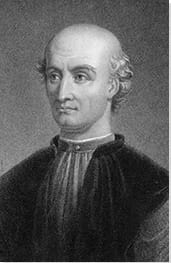Summary of Donato Bramante
Commonly regarded as the first, and possibly the greatest, of all the High Renaissance architects, Bramante represented the symmetrical ideal that would act as a template for later architects. Bramante took the finest elements of classical Greek and Roman antiquity and brought to them a modern variation that made them the defining features of the Renaissance. He is admired for simple, elegant structures, often built on a monumental scale. Having established a formidable reputation in Milan, Bramante, with Michelangelo and Raphael, was at the axis of the renewal of Rome and the city's rebirth as the cultural and artistic center of the Christian world.
Accomplishments
- Bramante designed some of Rome's most important buildings and monuments, including the Tempietto in San Pietro in Montorio, thought by many to be his defining work and the perfect example of Renaissance architecture. Featuring a classical facade and barreled center that soars through a ring of columns to meet its crowning dome, it is a style that has been repeated in civic and religious buildings throughout the Western world ever since.
- Bramante's training as a Renaissance painter helped him grasp the importance of precise mathematical proportions. He used these lessons to achieving harmony and balance in his architecture. He also took on board the rule of antiquity that stressed the proper use of orders (or types) of architectural columns. Bramante would duly create his own designs based around the classical principles.
- Bramante helped standardize the orientation of church designs in accordance with the Renaissance ideals of perspective, symmetry and axiality. He is credited with being the first architect to harness the painterly trompe l'oeil effect whereby, through a combination of sculptural relief and painted architectural perspective, he created the illusion of a much deeper interior space, such as the choir for Milan's San Satiro church.
- Bramante was employed in Duke Ludovico's famous Milanese court where he mingled with some of the greatest figures in Renaissance art and learning. His architectural designs were influenced by the classical and humanist ideas he learned and shared with friends and mentors including the mathematician Luca Pacioli; the painter (and great polymath) Leonardo da Vinci; and the sculptor and medalist, Gian Cristoforo Romano.
The Life of Donato Bramante
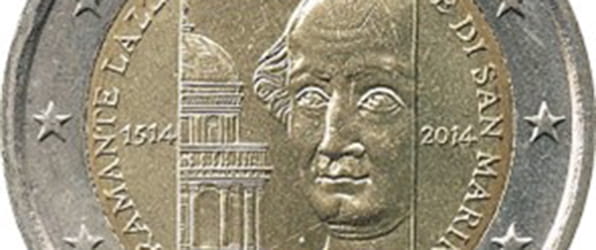
Speaking of Bramante's legacy, the American abstract artist and architect Richard Meier wrote, "We are all affected by Le Corbusier, Frank Lloyd Wright, Alvar Aalto, and Mies van der Rohe. But no less than Bramante, Borromini, and Bernini. Architecture is a tradition, a long continuum. Whether we break with tradition or enhance it, we are still connected to the past".
Important Art by Donato Bramante
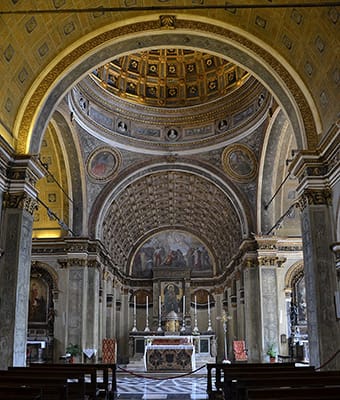
Santa Maria presso San Satiro
One of Bramante's earliest Milanese commissions was for the basilica church of San Maria press San Satiro. Due to spatial constraints, the church could only accommodate a shallow (about 3ft) choir. Bramante used a combination of sculptural relief and painted architectural perspective to create the illusion of a much deeper space. He also designed other elements of the church, placing a barrel vault over the nave, and installing the first coffered dome since the age of antiquity.
Bramante's creative solution for the choir problem at San Satiro is widely considered the first trompe l'oeil in architectural history. His wider work in the church also shows the influence of Leon Battista Alberti (in the use of the barrel vault), Andrea Mantegna (in the use of perspectival effects), and Brunelleschi (in the style of the arched cloister in his Ospedale degli Innocenti in Florence). However, historian Peter Murray maintains that a "feeling for architectural space as a series of planes and voids, like those in a painting [as Bramante himself demonstrated in his painting, Cristo alla Colonna (Christ at the Column) (1490-95)], rather than a series of three-dimensional solids, like in architecture, distinguishes Bramante from Brunelleschi and from most of the Florentine architects of his own generation".
Milan, Italy
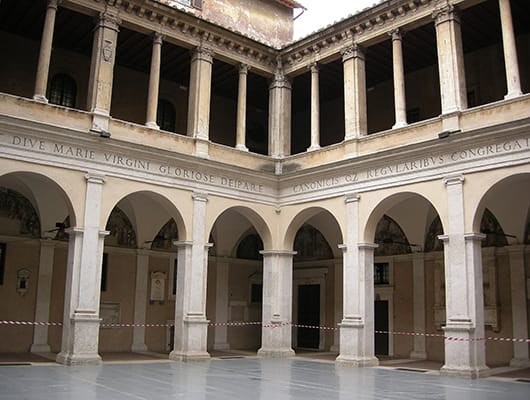
Cloister of Santa Maria della Pace
Pope Sixtus IV commissioned the votive church of Santa Maria della Pace in 1482 following a pledge he had made when asking for the Virgin's guidance in reaching a peaceful conclusion to a conflict with Florence in the wake of the so-called 1478 "Pazzi conspiracy" (where members of the Pazzi family had carried out a failed coup to overthrow Florence's all-powerful Medici family). The Church remains best known, however, for the later addition of Bramante's cloister (courtyard), commissioned in 1500 by Cardinal Oliviero Carafa. The cloister serves as an early example of the use of piers (platforms) to complement courtyard loggias (galleries). It was a practice that would quickly become a standard in 16th century architectural design.
Having arrived in Rome in 1499, Bramante immediately took to studying the ancient monuments dotted in and around the city. Here, his use of piers, rather that columns, to support the arcades was likely inspired by the Benediction Loggia in the Vatican which was designed by Alberti around 1455. By positioning columns over arches, moreover, Bramante rejected the architectural norm of placing supports above supports, and openings above openings. This modernization was necessitated because of the discrepancy in height between stories (the ground story being significantly taller than the upper). It was a discrepancy in scale that meant that the proportions of the arches would have had to differ significantly between stories.
Bramante's solution to this problem was to use different forms of construction. Instead of repeating the arcuated (curved like a bow) loggia of the lower storey, he switched to trabeated (beamed) construction on the upper storey and subdivided the bays using free-standing columns. The columns functioned both as a structural support for the entablature (inscribed friezes) above and worked aesthetically to create proportional continuity across both stories. The piers are decorated by columns from different orders - Ionic on the ground storey, and Composite for the upper - and follow the principle of increasing ornateness as the stories rise.
Rome, Italy
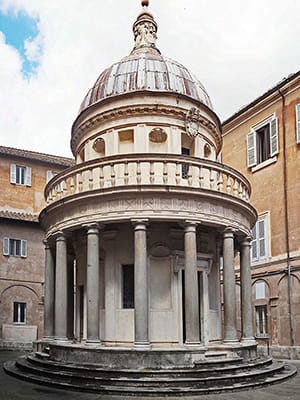
Tempietto of San Pietro in Montorio
Universally admired for its elegant simplicity, the Tempietto of San Pietro in Montorio is Bramante's masterpiece. Standing in the courtyard of the San Pietro in Montorio church, the small (about 4 meters in diameter) temple serves a memorial (rather than practical) function. Often cited as a prototype of the epic St. Peter's Basilica in the Vatican, Bramante's structure came to be seen as the very embodiment of architectural precision. Built of the site of St. Peter's crucifixion, Bramante took his inspiration from ancient buildings, such as Rome's Temple of Vesta, and the Roman Pantheon. It consists of a single chamber temple with a half-sphere (hemispherical) concrete dome, and a symmetrically-spaced series of niches and pilasters on the main body. The exterior is finished by a ring of columns built in the plain Tuscan Doric form. Bramante originally intended for the Tempietto to stand in the center of a circular colonnaded courtyard, although this was never realized.
Architectural historian James Stevens Curl explains that "Tuscan Doric was used because of its association with the strong masculine character of St Peter, on the supposed site of whose Martyrdom the Tempietto was erected. Indeed [Italian mannerist architect Sebastiano] Serlio credited Bramante with adapting the Doric temple [as the most] appropriate for heroic, masculine deities". The circular plan of the building, meanwhile, references Ancient peripteral temples as well as Early Christian martyria (tomb coverings). The building's perfect proportions exemplify the Renaissance revival of classical approaches to architecture and the blending of classical and Christian ideas. Says Curl, "the effect is graceful, serene, and Antique".
Rome, Italy
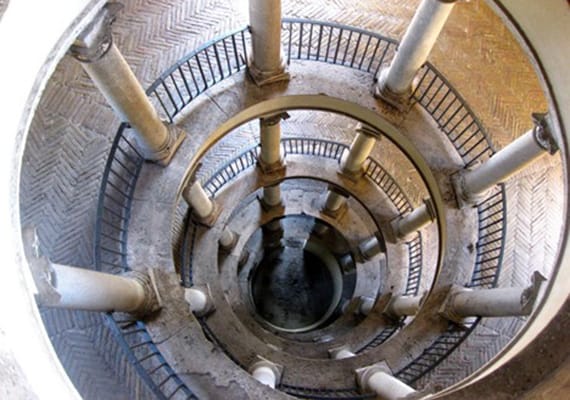
Bramante Staircase
This staircase, commissioned by Pope Julius II, is located in a square tower of Pope Innocent VIII's Belvedere Palace (now part of the Pio-Clementine Museum), connecting the palace to the outside. It stands about sixty-two feet high and takes the form of a double helix with four and a half spiral turns. Thirty-six grey granite columns stand on the interior. The order of the columns changes with each spiral turn, with Tuscan at the bottom, followed by Doric, Ionic, and Composite. The width of the columns decreases by about half on each spiral turn from bottom to top, though their length remains equal. The staircase is, in fact, a ramp, paved with a herringbone pattern (perhaps inspired by Brunelleschi's ingenious use of herringbone masonry in the dome of the Florence Cathedral) allowing for riders and carriages to easily ascend and descend.
The Bramante Staircase was part of a much larger construction project which connected the Belvedere Palace to the Vatican Palace via an extended courtyard. Bramante's original design for the courtyard included three terraced levels (the lowest of which served as a theatre) joined by monumental stairs and defined by arcaded loggias with superimposed orders, with narrow wings on each side. As in many of his works, Bramante drew influence from the ancient monuments in and around Rome. Architectural historian Arnaldo Bruschi explains that, in the Belvedere Courtyard project, "the Doric, Ionic, Corinthian arrangement of orders for the three-level lower terrace echoed the Colosseum's elevation, and the entire terraced complex was reminiscent of imperial palaces on the hills of ancient Rome". However, many alterations to the courtyard's design have since taken place, and, apart from the Bramante Staircase, Bramante's total vision is no longer recognizable.
Bramante's staircase served as the inspiration for the passageway at the well of San Patrizio in Orvieto (1527-37), designed by Italian Renaissance architect Antonio da Sangallo the Younger, and the more modern staircase, also in the Pio-Clementine Museum, designed by Giuseppe Moms and built in 1932. The latter, in turn, influenced Frank Lloyd Wright's iconic design for New York's Guggenheim Museum (1956-59).
Vatican Museums
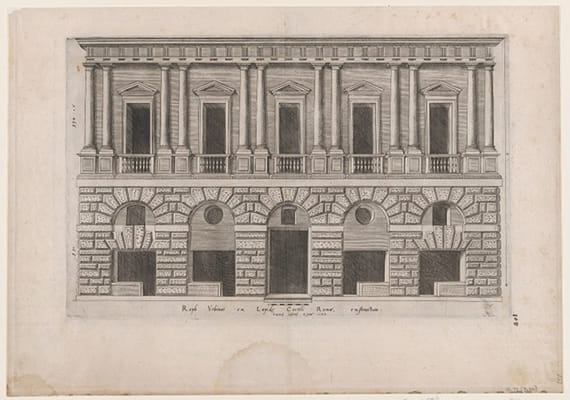
Palazzo Caprini
The Palazzo Caprini (also known as the House of Raphael, as it was later occupied by the great High Renaissance artist), featured an arcaded and heavily rusticated and stuccoed ground floor (which would have housed shops), and a second floor with coupled Tuscan Doric half-columns and a complete entablature above. The building stood in the Borgo neighborhood of Rome, and has now been destroyed, though the façade is known to us from an etching by Antonio Lafreri and a partial sketch attributed to Andrea Palladio.
Bramante's design for the Palazzo Caprini went on to become the standard model for integrating a rusticated ground floor with arched openings and the classical orders, as well as for the use of large voussoirs and keystone instead of a lintel over the rectangular openings of the shop fronts. Its influence can be seen in the design of many other palaces, particularly in northern Italy in the 16th century, by architects like Michele Sanmicheli, Giulio Romano, and Palladio, and, by extension, in Britain and Ireland, through the work of architects Richard Boyle, 3rd Earl of Burlington, and Sir William Chambers, who brought neoclassical and Palladian architecture to the region in the eighteenth century.
Rome, Italy
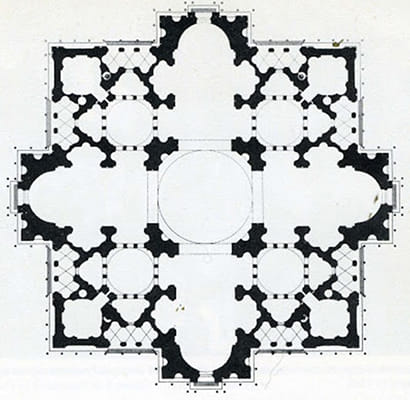
St. Peter's Basilica
Bramante's most prestigious and monumental commission, which he won in a competition against architects Giuliano da Sangallo and Fra Giocondo, was to design the new St. Peter's Basilica in the Vatican. As Curl explains, besides the fact that the old St. Peter's had fallen into a state of disrepair, it was also a Constantinian basilica, and thus following the fall of the Church of Hagia Sophia in Constantinople to Islam in the mid-fifteenth century, it became "politically and symbolically important" to replace the design. Bramante played a significant role in the demolition of the old basilica, earning him the nicknames of "Maestro Ruinante" or "Maestro Guastante" ("Master Wrecker" or "Master Breaker").
Although he passed away early in the construction process, and many alterations were made under the direction of others - including Michelangelo - several key elements of Bramante's original design remain today. He first intended for the church to sit on a centralized and symmetrical Greek cross plan (symbolizing the "Perfection of God"), with a large dome sitting on a colonnaded drum at the crossing, with four small domes above each arm, each arm terminating in an apse, and corner towers between the arms. However, the Greek cross plan was rejected by Pope Julius II, so Bramante lengthened one arm to form a nave, and added ambulatories in the apsidal arms. For the dome - to be the tallest in the world - Bramante drew inspiration from the Pantheon in Rome, as well as from Brunelleschi's ingenious dome of the Florence Cathedral.
Michelangelo had thought of Bramante as his nemesis, and jealous of his superior talents. While there is no evidence to support his claims, Michelangelo accused Bramante of being behind a plot to have him poisoned, and that he only recommended him (to Julius II) to paint the ceiling of the Sistine Chapel because, being primarily a sculptor, Michelangelo was bound to fail. Nevertheless, when he took over the St. Peters project after Bramante's death, Michelangelo conceded "One cannot deny that Bramante was as skilled in architecture as anyone since the time of the ancients. He it is who laid down the first plan of St Peter's, not full of confusion, but clear, simple, luminous, and detached in such a way that it in no way impinged upon the Palace. It was held to be a beautiful design, and manifestly still is".
Vatican City, Rome
Biography of Donato Bramante
Childhood
Donato Bramante (sometimems known as Bramante Lazzari) was born Donato di Pascuccio d'Antonio. He was the son, as the art historian and contemporary of Bramante, Giorgio Vasari, recorded, "of poor but honest" farmers. He was fairly well educated, however, and that "besides reading and writing, he practiced much at the abacus". Bramante's father encouraged him to pursue a career as an artist as he noticed that the boy "delighted much in drawing" and considered that to be a potentially fruitful career for his son. Little else is known of Bramante's early life but, according to historian Mark Cartwright, "Early on, Bramante was interested in the perspective effects employed by Andrea Mantegna in his paintings and frescoes. Interestingly for Bramante's future career, these illusionary techniques very often involved elements of architecture".
Education and Early Training
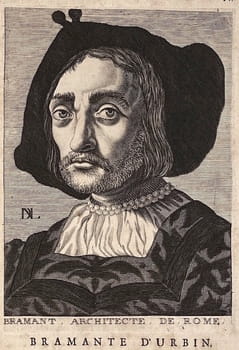
Vasari noted that the young Bramante eagerly studied the works of painter Fra Bartolomeo. It is also likely that he served as an assistant to Early Renaissance painter Piero della Francesca while residing in the humanist hub of Urbino. Architectural historian Arnaldo Bruschi notes that it is also quite possible that "he learned much by traveling" and encountered works by Mantegna (in Mantua and Padua), Leon Battista Alberti (in Rimini and Mantua), Ercole de'Roberti (in Ferrara), and Filippo Brunelleschi (in Florence).
Although Bramante was considered "unlettered" (as he did not know Latin or Greek) he was by no means uncultured. In addition to his skills in drawing, painting, and architecture, he was also an amateur musician and a keen poet. He was passionate about Dante and wrote a number of sonnets during his lifetime. As Bruschi writes, Bramante "seems to have been an extravert. He was said to be very friendly to persons with talent, and he did much to help them. Humour, irony, a taste for intelligent jokes, and mockery of himself as well as others often appear in his sonnets. Full of faith in himself, he was an irreverent person who took pleasure in proposing paradoxical ideas. He was critical of priests and courtiers but also capable of deep religious feeling. In the treacherous atmosphere of courts, he was able to maneuver skillfully".
Mature Period
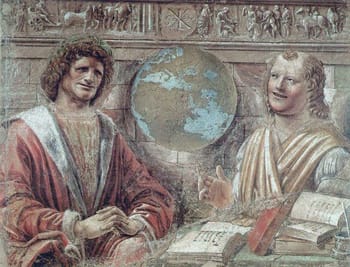
It is known that by 1477 Bramante had left Urbino for the province of Lombardy. He worked for a time as a painter in Bergamo, focusing on illusionistic architectural murals, many of which included trompe l'oeil effects and perspectival effects similar to those used by Mantegna. His first known work was a 1477 fresco of Greek philosophers in a frieze on the facade of the Palazzo del Podestàat Bergamo. But as Cartwright writes, "Next to no other biographical details survive of what the young artist did up to his mid-thirties [...] even if it seems he never gave up painting entirely".
Around 1480, Bramante arrived in Milan where he observed the construction of the cathedral and engaged in an exchange of knowledge and ideas with the Italian, German, and French craftsmen in the cathedral workshop. Bramante went on to import the Renaissance style to Milan, contrasting with the predominantly Gothic architecture in the city. He joined the court of Ludovico Sforza (reigning subsequently as regent and Duke between 1480-99) who appointed Bramante as court architect. He commissioned Bramante to work on his first major project, the church of Santa Maria presso San Satiro (1482-86) (the first architectural structure to be definitively attributed to him). He created the trompe-l'oeil choir of the church (giving the impression it was bigger than it was) while the east exterior was designed to give the illusion of perspective that he'd learned from Renaissance painters. The church was the first indication Bramante's own vision and individualism.
During this period, in which he also contributed to projects in the nearby cities of Pavia and Legnano, Bramante formed a close friendship with Leonardo da Vinci who had joined Ludovico's court in 1482. Cartwright states that Leonardo "would have introduced [Bramante] to the work of the great Florentine architect Filippo Brunelleschi, who famously designed the great Dome of Florence's cathedral and whose views on perspective and reconsideration of architectural and urban spaces were influential throughout the Renaissance. Brunelleschi promoted classical proportions, simple geometry, and harmony in a new architectural language which challenged the hitherto dominance of medieval architecture. Another influence on Bramante was the work of the architect Leon Battista Alberti also an advocate of boldly reusing features of classical architecture".
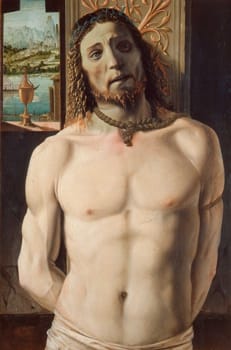
The oil on panel painting, Cristo alla Colonna (Christ at the Column) (c. 1490), housed at Milan's Pinacotea di Brera Gallery, is presented as an original Bramante. It shows the muscular (sculpted) body of Christ strapped to a column decorated with a classical Renaissance floral motif like those in Bramante's Santa Maria sacristy. The landscape, too, which we see through the window over Christ's right shoulder, suggests the influence his friend and colleague, Leonardo. The Brera states, "On the horizon a blurred landscape [reminds us that] Leonardo has already left his legacy in Milan", while Bramante's skill at creating the illusion of space through the trompe-l'oeil technique, is strongly suggested in "a number of compositional devices - the sculptural body occupying the foreground, the window, the pillar extending beyond the physical limits of the picture - [that] suggest the existence of a large room in which Christ is being tormented".
In 1488, both he and Leonardo submitted entries for a competition for the design of the cathedral cupola, and two years later they worked together to solve structural and stylistic issues of the cathedral's tiburio (crossing tower). Despite being in good favor with both the Duke and his brother, Cardinal Ascanio Sforza, Bramante continued to earn only a modest living. It was also around this time that Bramante is believed to have begun mentoring his pupil, Bartolomeo Suardi, more commonly known as "Bramantino".
Bruschi characterizes Bramante's activities moving into the 1490s as "restless". It is believed that in early 1492, he was in Florence studying the dome of the cathedral, which Brunelleschi had completed a few decades earlier. He worked on a number of projects in the town of Vigevano (near Milan) between 1492-94 while at the same time working on the Castello Sforzesco in Milan. In 1493 the Duke instructed Bramante to make a report on the effectiveness of fortifications along Lombardy's border with Switzerland and he worked on the redesign and organization of public events and spectacles (such as baptisms). Cartwright adds that although he was "always busy with his chief patron's many projects, we know that in his free time the architect wrote sonnets and was a keen amateur musician. Bramante's poetry reveals a keen sense of humour and a man who did not take himself or life too seriously".
Between 1492-97, Bramante worked on Milan's Santa Maria delle Grazie church, most famous today for its refectory which is home to Leonardo's fresco masterpiece, The Last Supper (1495). It is likely Bramante was responsible for the design of the church's new apse, transept, crossing, and dome (today the church is marked a UNESCO World Heritage Site). Also between 1492-97, Bramante worked on the new canonica (clergy residence) and cloisters for Milan's Sant'Ambrogio Basilica (some of his unfinished plans were implemented as recently as 1955) and Cistercian Monastery (though the latter project was suspended in 1499). Around 1497, both he and Leonardo submitted models (although the latter withdrew his entry) for a competition to design a new pronaos (vestibule) for the 14th century Church of San Maria Nuova. As the Church's literature explains, "It was probably the need to regularize, at least visually, the orientation of the church according to the Renaissance canons of perspective, symmetry and axiality that determined the start of the construction of the porch. However, the exact understanding of his construction history still appears uncertain, as does its stylistic and attributive evaluation, which are also very problematic since the traditional reference to Bramante has lately been questioned by many quarters".
Late Period and Death
In 1499, prompted by the invasion of Milan by the French army (and forcing his patron Ludovico Sforza to flee the city) Bramante travelled to Rome, possibly at the invitation of his friend, the powerful Cardinal Riario. He became "Under-Architect" for Pope Alexander VI and served on a number of architectural councils. As part of his new role, Bramante spent long hours wandering the city's streets, studying its ancient monuments. He also visited Naples where he befriended the wealthy and influential Neapolitan Cardinal, Oliviero Carafa, and who later commissioned him to design the monastery and cloister for the Santa Maria della Pace in Rome (completed in 1504).
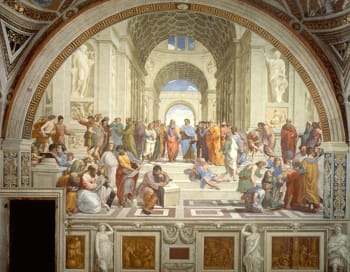
One of Bramante's early Roman designs (c. 1501) was for the Palazzo Caprini, which is also referred to as the "House of Raphael", given that Raphael took up residence there in 1517 (Bramante's original design is now unrecognizable after renovation works undertaken in the late sixteenth century). The two me men had in fact worked closely together on Raphael's great Vatican fresco, The School of Athens (1511). As a mark of his gratitude, Raphael painted Bramante into the work as the Greek mathematician Euclid. He also painted Bramante into a fresco on the opposite wall, La Disputa (1510), as himself in this instance, in the left foreground showing a book to painter Fra Angelico.
During his early years in Rome, it is also likely that Bramante designed a number of monumental fountains including those in Piazza Santa Maria in Trastevere, and Saint Peter's square. In 1502, Bramante was commissioned to design the circular Tempietto of San Pietro in Montorio. Completed in 1510, Bramante's iconic structure was thought to be the first Renaissance building to be designed in accordance with the unadorned classical Doric order.
Bramante was taken under the wing of Cardinal Della Rovere when he became successor to Alexander VI in 1503. Rovere - or Pope Julius II to give him his Papal title - was a modernizer and a significant patron of the arts. He made Bramante his "Superintendent of Architectural Planning" as he embarked in earnest on the era known as Renovatio Imperii Romanorum ("renewal of the empire of the Romans"). Historian E. H. Grombrich wrote, "It was a memorable moment when [Bramante] found a mighty patron willing to sacrifice tradition and expediency for the sake of the fame he would acquire by erecting a stately structure that would outshine the seven wonders of the world. Only in this way can we understand the decision of Pope Julius II in 1506 to pull down the venerable Basilica of St. Peters, which stood in place where, according to tradition, St. Peter was buried, and to build anew in a manner which defied the age-old tradition of church building and the usages of divine service".
Bramante won the competition for the redesign the St. Peter's Basilica, beating plans by esteemed architects Giuliano da Sangallo and Fra Giocondo in the process. Work on Bramante's original symmetrical design - based on a square church, housing a cross-shaped floor, housed under a giant dome - was beset with problems stemming from the spiraling cost of such a grandiose project. Grombrich states, "admiration for the art of the ancients and ambition to create something unheard of overruled considerations of expediency and time-honoured traditions [...] The enormous building swallowed up so much money that, in trying to raise sufficient funds, the Pope precipitated the crisis which led to the Reformation. It was the practice of indulgences against contributions for the building of the new church that led Luther in Germany to his first public protest".
Work on the project continued long after Bramante's death. As Cartwright explains, "Bramante's lasting contribution to what would become Saint Peter's Basilica was the four giant piers and their arches. As it turned out, his original designs were changed, but the central cross of what Bramante had envisaged as a Greek cross plan, remained. Indeed, the centralised plan of the church would be much copied across Italy".
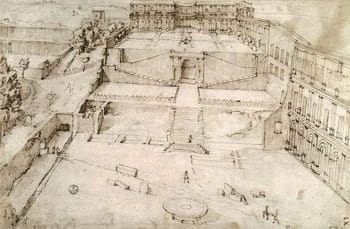
Bramante was also employed on the redesign of several of the roads and piazzas around the Vatican including, in 1505, the Belvedere courtyard which, with its terraces linked by symmetrical staircases, and lined with its Greek Doric, Ionic, and Corinthian columns, connected the northerly Vatican palaces with the villa of the 14th century Pope Innocent VIII (although Bramante did not live to see the finished courtyard). Bramante output in Rome was in fact little short of prolific. And to help accommodate such rapid expansion required, not just innovation in design, but in cheap and simple materials too. This saw Bramante become a pioneer in the use of cast vaults and stucco (exterior masonry finish).
Between 1505 and 1509, Bramante worked on an enlargement of the choir of Santa Maria del Popolo, as well as projects at the Castel Sant'Angelo and the Rocca di Viterbo. He accompanied the Pope on a 1506 trip to Bologna in the role of military engineer, and is said to have entertained the Pope every evening with his commentary on the works of Dante. It is believed that he also designed the grand staircase of the Palazzo deli Anziani in Bologna. Once back in Rome, he designed the Palazzo dec Tribunali (1508) and the church of San Biagio (1509), as well as a number of smaller churches and palaces. Although unconfirmed, it is thought likely that Bramante had some input on the final designs of Baccio Pontelli and Antonio da Sangallo the Elder's, Cancelleria Palace (1489-1513).
Following the death of Julius II in 1513, Bramante won the favor of the succeeding pope, Leo X, to whom he presented a bold plan for water control of the Tiber River which was prone to flooding. Later that year he was forced to turn down a commission for the Cathedral of San Feliciano in the town of Foligno due to his rapidly declining health. He passed away in April of the following year, He was buried in St. Peter's Basilica. Art historian Giorgio Vasari reported that he was carried to his final resting place "by the papal court and by all the sculptors, architects, and painters".
The Legacy of Donato Bramante
Architectural historian James Stevens Curl contends that Bramante was "The only architect of the High Renaissance (with the exception of Raphael) respected by his peers and successors as the equal of the ancients, it was he, above all, who revealed the power, emotional possibilities, and gravity of Antique Roman architecture". Indeed, many scholars agree with Curl's assessment, Bramante having left his mark on some of the most significant buildings in Rome, including the great landmark, St. Peter's Basilica. But he was also a key figure in introducing Renaissance architecture to Milan, with architectural historian Arnaldo Bruschi observing that "Bramante's presence (together with Leonardo's) in Milan was of fundamental importance for the later artistic developments in that city".
Bramante's legacy has been lasting. His Bramante Staircase at the Vatican influencing modern-day designs such as Frank Lloyd Wright's Guggenheim Museum in New York City, and his circular Tempietto in Rome influencing the designs for Saint Paul's Cathedral in London and the United States Capitol in Washington D. C. The contemporary urban landscape of Rome, too, owes a debt to his city planning projects that shaped the many streets and piazzas near the Vatican.
Influences and Connections

-
![Leon Battista Alberti]() Leon Battista Alberti
Leon Battista Alberti -
![Andrea Mantegna]() Andrea Mantegna
Andrea Mantegna -
![Filippo Brunelleschi]() Filippo Brunelleschi
Filippo Brunelleschi - Fra Bartolomeo
- Ercole de'Roberti
-
![Leonardo da Vinci]() Leonardo da Vinci
Leonardo da Vinci -
![Raphael]() Raphael
Raphael -
![Piero della Francesca]() Piero della Francesca
Piero della Francesca - Melozzo da Forlì
![Richard Meier]() Richard Meier
Richard Meier- Cristoforo Rocchi
- Giulio Romano
- Andrea Palladio
- Richard Boyle
-
![Leonardo da Vinci]() Leonardo da Vinci
Leonardo da Vinci -
![Raphael]() Raphael
Raphael -
![Piero della Francesca]() Piero della Francesca
Piero della Francesca - Melozzo da Forlì
Useful Resources on Donato Bramante
- The Story of ArtBy E. H. Gombrich
- Church of S. Maria Nuova - complexLombardiaBeniCultural
- Donato BramanteBy Arnaldo Bruschi
- BramanteBy Arnaldo Bruschi
- Leonardo, Bramante, and the Academia: Art and Friendship in Fifteenth-Century MilanOur PickBy Jill Pederson
- Donato BramanteBy Mark Cartwright, World History Encyclopedia
- On BramanteBy Pier Paolo Tamburelli
- Bramante's Tempietto, the Roman Renaissance, and the Spanish CrownOur PickBy Jack Freiberg
- Renaissance Architecture (Oxford History of Art)By Christy Anderson
- The Architecture of the Italian RenaissanceBy Peter Murray
- Architecture of the Italian RenaissanceBy Christoph L. Frommel
- Emulating Antiquity: Renaissance Buildings from Brunelleschi to MichelangeloBy David Hemsoll
 Ask The Art Story AI
Ask The Art Story AI